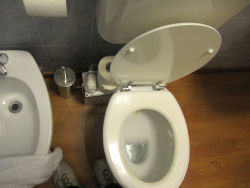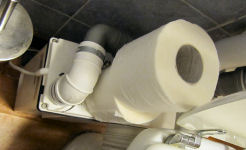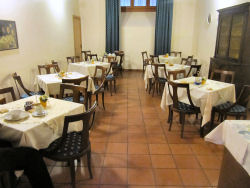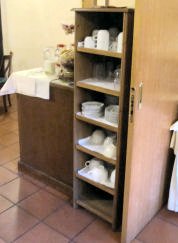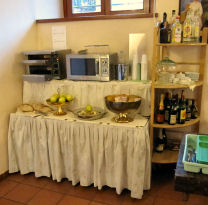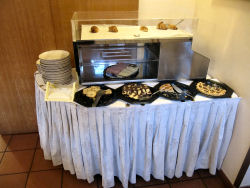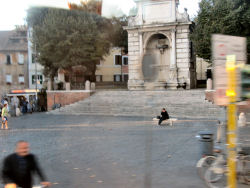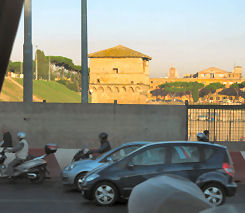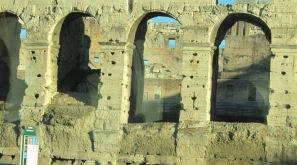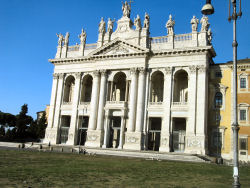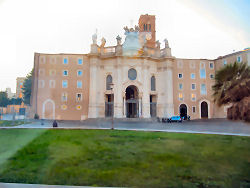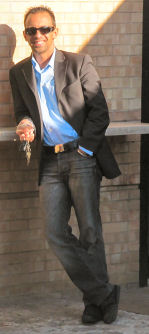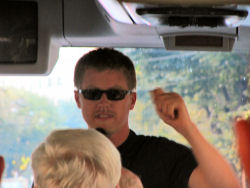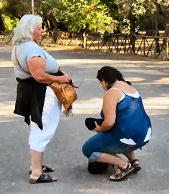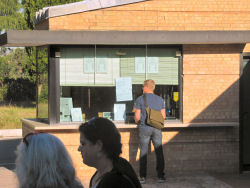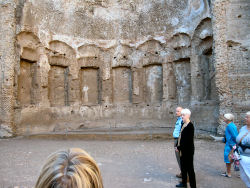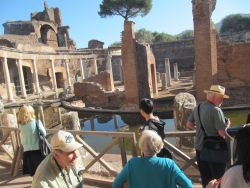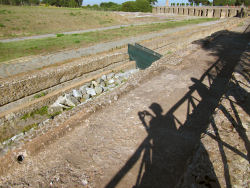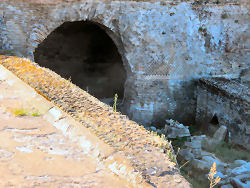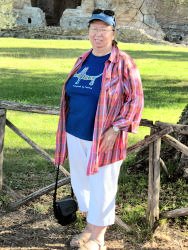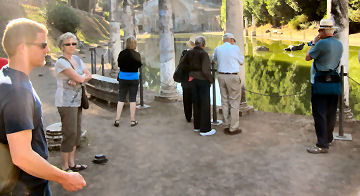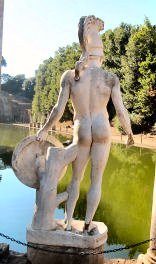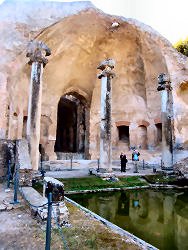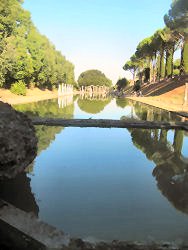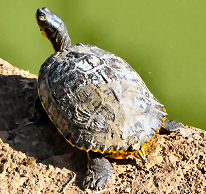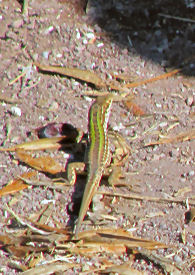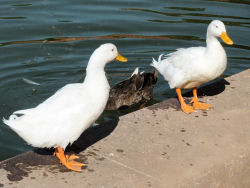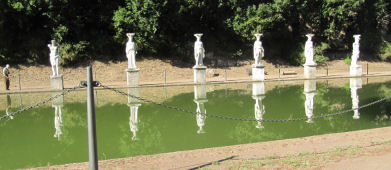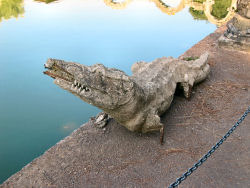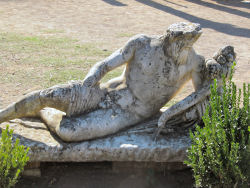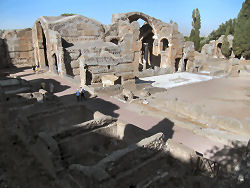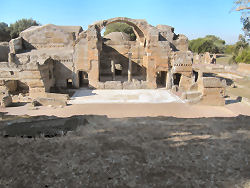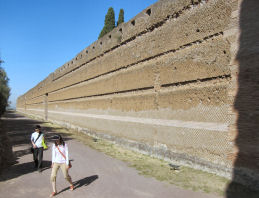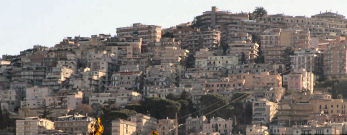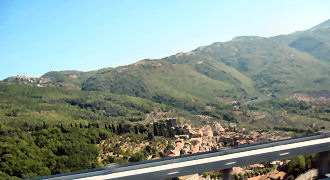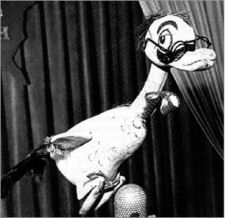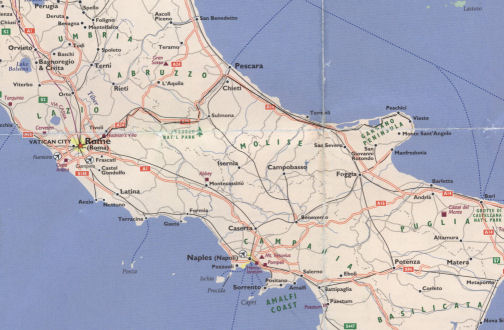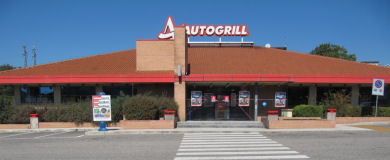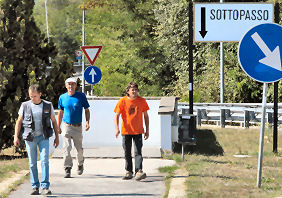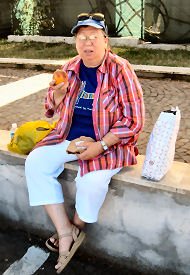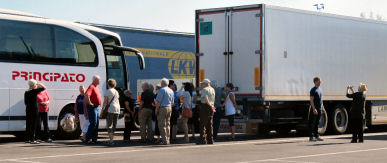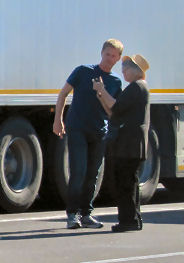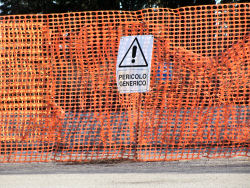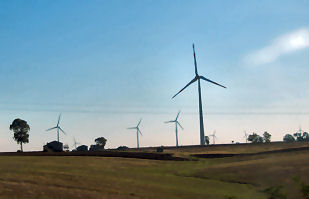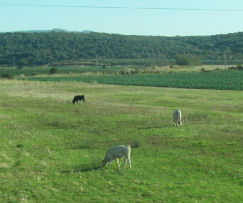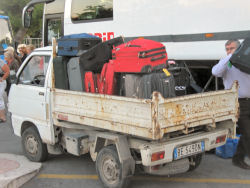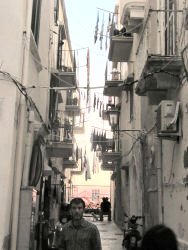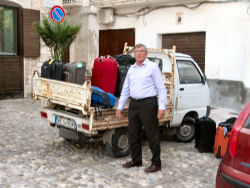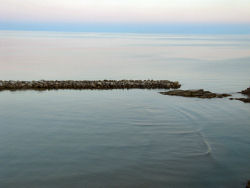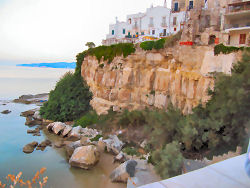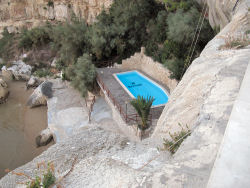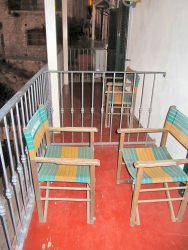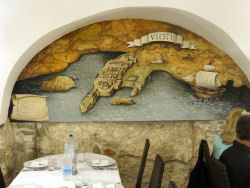This was the day that our Italian adventure changed dramatically. For Sue it was the day that the vacation actually began; by the end of the day she would be all the way across the country from the Corcorans. I was looking forward to setting aside the hectic schedule that I had outlined for myself for the Roman invasion and surrendering my attention to the back-door touring for which Rick Steves’ company was justly famous. This was also the first bus day of the tour, and it was by far the longest bus ride that was scheduled. There would be plenty of time to drink in the countryside and no opportunity to look for the tombs of the popes.
Sue and I had enjoyed our two days at Casa San Giuseppe. Our room was very nice. Sue’s problem with the electricity did not affect me at all, and I think that she found it more annoying than debilitating. The rooms in Casa San Giuseppe did have one very peculiar feature – a little box behind the toilet that in some manner governed the flushing. This device emitted peculiar noises at seemingly random intervals throughout the day and night. One thing that I had definitely noticed about European hotels was that the bathrooms were much less uniform than those found in the States. One would be astounded to find an American hotel with plumbing as outre as Casa San Giuseppe’s or one that featured the bizarre toilet paper dispensers of the Hotel Selene.[1] Maybe things were less uniform in American hotels in the days before the big chains began to dominate the hospitality industry. Mother Nature provided us with another perfect day. It seemed to be a little cooler in the morning, but the temperature was back up in the eighties in the afternoon.I was frustrated to discover that I could not locate the map of Italy that had been provided by the tour company. If there was ever a day on which I might want to consult it, this would be it.
We boarded our bus on the Lungotevere at Trilussa Plaza at about 8:30. Rainer introduced our driver, Giulio, a native of Palermo. He was scheduled to transport us on his bus, on which the word “Principato” was emblazoned in red, up to Sorrento. For some reason the itinerary called for a different bus and driver to take us from Sorrento to Naples.
The plan for the day was quite simple. We intended to stop in Tivoli for a couple of hours to see Hadrian’s villa, to eat lunch at an Autogrill, and to arrive in Vieste just before 6:30. We planned to eat supper together at the hotel’s restaurant.The bus had to pass through much of Rome to reach the A24 highway that led to Tivoli. I took some photos of the Colosseum as we passed, but the famous building was scarcely recognizable in them. It looked much more like an old stone building full of bullet holes.
Rainer also pointed out the church of Santa Croce in Gerusalemme as we passed it. I had heard of this church in conjunction with the millennial pope, Sylvester II. The legend was that the devil or perhaps the demon that inhabited the clockwork skull that the pope kept in his study had informed the pontiff that if he said mass in Jerusalem, he would die a horrible death. Pope Sly canceled his planned pilgrimage to the Holy Land. However, after he said mass in Santa Croce, which was then (and is now) often called “Jerusalem,” he was stricken with a horrible illness and died. This is one of those legends that only appeared in print more than one hundred years after the event supposedly took place. Rainer informed us that most Romans lived in apartments. It certainly was true that on our drive to Tivoli we saw almost no structures that resembled suburban houses in the States. Tivoli, the town near which Hadrian constructed his elegant villa, was only about twenty-five miles east of Rome. During the short drive there Rainer provided background information about Emperor Hadrian, who ruled the territory between England and Iraq from 117 to 138. He was born in Spain to a Roman family. He was something of a Renaissance man who was interested not just in conquest and power but also in philosophy, engineering, art, architecture, and quality of life.The Pantheon was constructed during Hadrian’s reign. Its 142-foot dome was the longest spanning structure until steel-reinforcing became available in the twentieth century.
Trajan, a very powerful man with no sons preceded Hadrian as emperor. Trajan had adopted a number of young men, but he did not officially name any of them as his heir. However, Hadrian was friendly with Trajan’s wife, Pompeia Plotina, who claimed that Trajan had named Hadrian as his successor just before he died. Hadrian had by that time organized a powerful covert police force, and he subtly employed it to consolidate his power. A suspicious and careful man, he understood how to keep his subjects happy and how to suppress any hint of opposition. Whereas Trajan had been bent on expanding the empire, Hadrian invested in infrastructure and concentrated on safeguarding the empire’s holdings. In addition to the Pantheon, he ordered the construction of roads, Hadrian’s Wall in northern England, and his massive mausoleum, now known as Castel Sant’Angelo. Hadrian traveled to all corners of his empire. He absorbed the artistic approaches of Greek, Egyptian, and other cultures, and then employed them into his own eclectic sense of style. In this respect he reminded me of what I knew of Emperor Frederick II, but more than one thousand years earlier. Hadrian’s masterpiece was the gigantic villa that he built in Tivoli. It contained libraries, courtyards, pools, and a system of underground tunnels used by the many servants. Rainer’s description reminded me of Disney World, which also has a secret city beneath the surface.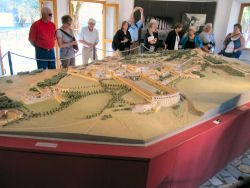
As we assembled around a model of what the villa probably looked like, it was impossible not to be impressed with the scope of this undertaking. Hadrian’s life here must have been idyllic. With such a nice place to stay, it surprised me a little that he had been so peripatetic.
Rainer then escorted us on a short tour through a portion of the villa.[2] We began at the Pecile, a gigantic structure that once contained a pool. What remained was a very long wall through which we had to pass to reach the rest of the villa. Rainer made sure that we could orient ourselves by the wall and the entrance. We then visited the Room of the Philosophers and the so-called Maritime Theater. The former, which featured a vaulted ceiling, was probably the place in which the emperor received visitors. Rainer explained that the flat bricks distributed the load of the vault. He said that the floors had been wooden, but all of the wood was long gone.The Maritime Theater, which had precisely the same dimensions as the Pantheon, was probably the emperor’s study. Not many people deploy a moat around their studies, but evidently Hadrian really valued his privacy. This was one of the best-preserved areas of the villa, and the architectural style was certainly unique.
The villa contained several huge baths, which the Romans heated by burning wood. Rainer said that every Roman had the right to bathe. The Romans may have deforested most of the continent, but they were clean. The villa would probably be in much better condition than it was, but many of the buildings had supplied the raw materials for the construction of the Villa d’Este, which was up on the hill in Tivoli.Hadrian had no children. He was succeeded by one of his adopted sons, Antoninus. Hadrian also specified that Antoninus would adopt Marcus Aurelius and name him as his successor.
Our guided tour ended at Canopus, a long lovely water basin that brought home just how elegant this place must have been. It was integrated into the topography of the landscape in the Greek manner. Part of this area – at the very least the statue of Hermes and the Caryatids – had been reconstructed, so it was not exactly clear just what it originally looked like. Rainer told us that the pine nuts used in pesto come from the umbrella pines that were all around us.The worst aspect of the visit was the inclusion of obtrusive modern sculptures scattered throughout the area. Rainer gave the usual spiel about how they had to increase the price of admission to support the producers of this art. He noticed that I scoffed at this notion. To me every one of the pieces detracted from the experience.
The high point of the visit might have been the discovery of a real turtle on the edge of the pool. We later saw some ducks who had apparently formed a threesome and a small lizard-like creature.
Rainer allowed us quite a bit of time to roam around the villa. I wandered around, climbed up as high as I could get, and took quite a few photos from diverse angles, but I cannot claim that I got much out of the experience. I had to admit that prolonged exposure to ruins was not my idea of a great time.
I had trouble remembering where Rainer had told us the toilets were. In fact, they were on the opposite side of the pecile, as I thought. I failed to understand that they were underground, but I eventually located them. There must have been an attendant there, but I never encountered him or her. A blaring radio made the experience surrealistic. There were no seats on the toilets, but I cannot complain too much because both toilet paper and paper towels were available. Paper towels were rare in Italy.[3]
I located Sue, and we walked down to the bus together. She related that Benino seemed to be using his time in Italy to try to get in touch with his feelings about his sexuality. Too much information! La-la-la-la-la.
On the bus Rainer described a book called Memoirs of Hadrian by Marguerite Yourcenar. In it she hypothesized how Hadrian might have explained his philosophy to Marcus Aurelius. This was not actually too different from my own idea about explaining the life of Pope Benedict IX in a first-person narrative. I wondered how she got anyone to take her seriously. Pope Benny was probably not the philosopher that Emperor Hadrian had been, but I bet that his life was just as interesting. Gregorovius described him as “a demon from hell in the disguise of a priest.” I doubted that he had actually been that evil; he was pope for fourteen years. Practically everything written about him comes from a few monks who were itching to get their hands on the papacy. I have long suspected that they probably had it in for him.
Hadrian’s villa was located a short distance from Tivoli proper, which, like many Italian cities, occupied the top of a hill. We got a pretty good view of the town as we passed, and I think that at least one of the photos that I took through the window of the bus was passable.Somehow the topic of coffee arose on the bus. Rainer explained how he had come to appreciate the Italian approach to the beverage.[4] They consume it in small (but very strong) doses many times throughout the day. When he went home to Seattle, he was now able to look down his nose at the coffee snobs there.
We had a short vocabulary lesson. “Macchiato” is an espresso shot with a little frothed milk. If you order a “latte,” you will be brought some milk. Some places served an undrinkable concoction called “Caffè americano.” “Caffè corretto” was spiked with a little grappa.At this point Groucho’s bird came dropping down from the ceiling with $100 in its mouth. “Grappa” was the secret word, and Frank Buonpane came to life. Grappa was what made life worth living for him, and he wasted no opportunity to praise its benefits.
Rainer then introduced us to the notion of “bella figura,” the sine qua non for Italians. The concept was similar to the concept of “face” as in “saving face,” but there was a little more to it. Italians seemed to possess an idealized conception of the way that they presented themselves to the world. It was critically important that one did nothing to harm that image. If one did, one was making a “brutta figura.”I love Italy, but some painful soul-searching led me to the conclusion that I would make a poor Italian. I habitually pay virtually no attention to appearances, and I expend very little effort at making a good impression. People almost always find me insufferably arrogant when they meet me. I admit to being arrogant, but after they get to know me, most people consider me at least marginally tolerable.
We stopped for lunch at an Autogrill that was actually on both sides of the highway. The one on the other side, according to Rainer, served meals and had a greater selection of things to buy. I walked through the tunnel under the road (sottopasso) and went inside. I had already decided to skip lunch, but I wanted to buy something on which to nibble if I got hungry later. I found a huge bag of “biscotti rotti” for €5. I probably exhibited a brutta figura by purchasing them, but they tasted good and lasted me almost all the rest of the vacation. I shared some of the cookies with Sue and with Charlotte Zieve. They both seemed to think that they were pretty good.The Autogrill was, at least to some extent, powered by solar electricity. We also noticed that the countryside east of Tivoli was dotted with windmills. It seemed nice that some people were taking the problems with fossil fuels seriously.
For the first and only time on the trip we had to wait for Giulio to come open up the bus. Maybe he was unfamiliar with the American concept of “bun on the run.” Judy made Rainer pose for a photo while we waited. I was sitting some distance from the group and took a meta-photo. From Tivoli we motored east on the A25. We passed through the Appenine mountains, the long chain that runs all the way down to the toe of the boot. No one in Italy lives far from the sea, and no one lives far from the mountains. The highway ran toward Pescara, a port city in Abruzzo. At that point Giulio made a right turn onto the A14. Giulio drove us through the region of Molise towards our destination of the Gargano peninsula in Puglia. Rainer told us about Silvio Berlusconi, the right-wing President[5] of the Council and therefore Prime Minister. He controlled approximately 90 percent of the media in the country. Over his seventeen-year political career he had made numerous outrageous gaffes, including saying that German leader Gerhard Schröder would make a great Nazi. Nevertheless, by never backing down he always seemed to turn his missteps to his advantage. Even the notorious bunga-bunga parties at his Sardinian villa had hardly affected his popularity.I already knew quite a bit about Il Cavaliere’s history. IMHO, if anything, Rainer went easy on him.
Rainer had strong opinions on the Amanda Knox[6] case. He reported that he had argued about this controversial case with several of his Italian friends. He thought that the charges were trumped up, and few Italians seemed concerned that she had spent so much time in jail. Rather, people were appalled at her behavior in custody – she allegedly did cartwheels. This violated the Italian sense of “l'arte di arrangiarsi,” a concept not far removed from bella figura. I could tell that, as much as Rainer liked and respected his Italian friends, he found this attitude frustrating and indefensible.
Rainer said almost nothing about Molise, but he did tell us about its southern neighbor, Puglia. That region, along with the land along the Po River in the north and Sicily, were the chief agricultural areas in Italy. I knew about the Po valley and Sicilian farms, but I was surprised to learn that Puglia was flat enough to be farmed extensively. The explanation is that the Appenines go down from the Po to the toe of the boot; Puglia occupies the heel.Rainer tried to explain Italy’s rather Byzantine concept of commerce. Manufacturing was concentrated in small and medium-sized factories producing luxury goods. Almost every company in Italy was controlled by one family or another. The children inherited the businesses from their parents. Exceptions were almost non-existent.
It certainly came as surprising news to learn that real estate speculation was rampant in the south of Italy. I knew that some northerners had purchased abandoned properties and invested in novel twists on the hospitality industry, but I did not know that the real estate market in southern Italy was experiencing a general boom. 2011, after all, was a year of tight credit.
As the Connecticut contingent had already learned first hand, emergency medical care was free or very cheap in Italy. Italians carried health insurance only for surgical procedures and the like. This distinction might explain why the doctors at Policlinico kept Patti in Pronto Succorso for the entire time that she was there.
Post offices in Italy were a little different. For some reason people paid their bills there. The cost of a stamp for a postcard had risen to €1.60! Rainer said that few people seemed to realize this yet.Once or twice I dozed for a few minutes during the silent periods. I was very happy that I had brought my blue U-shaped pillow along.
We passed by a few cattle and pigs in the fields and quite a few wind farms. On the left side of the road was a smattering of coastal lakes between the Adriatic and the highway.
We made a brief pit stop at another Autogrill. This one had no sottopasso, but it did feature an array of solar panels.
If Italy is a boot, the Gargano Peninsula is the spur. The topology changed drastically as soon as we entered it. Tree-covered mountains that rose almost immediately from the sea dominated its interior. The peninsula contained Italy’s only old-growth forest because the Romans did not bother to conquer it due to its isolation and rugged landscape. The road twisted incessantly. Giulio had to ride the horn around blind curves.
Off and on I tried to work on the computerized version of my journal during the bus ride. I got a little bit done, but it was hard to concentrate. I kept my computer on, however, and eventually I had to go to my backup battery. When we reached the Gargano Peninsula, I started to get a little carsick. I turned the computer off and concentrated on taking blurry pictures of the countryside.
Until quite recently fishing had been the predominant industry of the coastal villages on the peninsula. The fishermen employed an arrangement of poles and nets called a trabucco. Fishing was still important in 2011, but to a large extent the Adriatic had been fished out, not due to the locals but because of the huge trawlers that captured fish en masse.
Rainer pointed out the prickly pears growing on the side of the hill. He said that they made a great marmalade.
We passed the fishing village of Peschici. All of the buildings there were white. It was like a night game at Penn State.Sue and I were assigned room 107 at the Hotel Seggio, an old building that had been remodeled. The bus could not get very close to the hotel. To reach it, we needed to negotiate a fifteen-minute walk through the town of Vieste. Giuseppe, the owner of the hotel, met us at the bus with a small truck. He piled our luggage on it, drove it to the hotel, and then unloaded it himself. Italy was not exactly known for its work ethic, but again and again the proprietors whom we met on Rick Steves tours seemed willing to go the extra mile for us.
The hotel had the peculiar policy of not allowing food or drink in the rooms. Rainer warned us that if we had any comestibles, we should be circumspect about them. We also would be responsible for purchasing our own drinks at tonight’s meal.I knew that I needed to introduce my buddy to the group on Thursday evening. On the walk to the hotel I interviewed Connie Hoverkamp in order to obtain enough material for my speech. I learned that Bob had operated a private dentistry practice since 1972. He had been a dentist in the Air Force at the age of twenty-one. The couple had three children and four grandchildren. The fifth was due in November. Bob liked to hunt wild turkeys and pheasants. He had recently purchased a Baretta shotgun and had talked the salesman into giving him a hat.
This was more than enough information on which to build my speech. The big decision was whether or not to make a joke about Hunter S. Thompson’s kind of Wild Turkey.I carried our luggage up the wide marble staircase to room 107. This hotel used the “big key” philosophy that predominated in small European hotels. Sue much preferred to have her own key. She did not like to leave the key at the desk.
Room 107 was absolutely beautiful. It had a double bed and an extra room with two twin beds. Its most outstanding feature was the balcony with dramatic views of the Adriatic as well as the hotel’s swimming pool far below.
Supper was served at the hotel’s restaurant at 7:30. Sue and I sat a table with Tom and Kathy Neithercutt, Steve Royce and Edie Martinelli, Gail Glode, Wilson Cheung, and Ching Fong.
Tom sat on my left. I learned that he had a business that produced precision tools and parts. He told me about an African trip on which he had been with a friend of his from a non-governmental charitable organization. The deplorable conditions that he encountered there made a deep impression. He and Kathy had been on two previous Rick Steves tours.
On their trip to Sardinia Kathy had been stung by something and broken out in some way. They both watched their diets very carefully.
Steve confessed to being a retired professor of psychology. He had taught at the University of Portland. Edie had an Italian mother. She loved to learn foreign languages.Gail had three children. One was in school; the other had gone to cooking school. The third, of course, was Amy, who was on the tour with us.
Wilson and Ching, I think, were born in Hong Kong. They were at the other end of the table. I may have gotten this wrong.
Dinner started with a fritata with tuna and cheese that I found absolutely delicious. It was followed by a vegetarian lasagne, swordfish, and tiramisu with chocolate and some kind of cream. Sue bought a bottle of white wine that we shared with Gail. It was a very nice dinner.I was beginning to relax. I liked Vieste. I liked the hotel. I liked our room. I felt good.
That complacent feeling came to an abrupt end when I signed on to the Internet. I discovered a worrisome e-mail from Bank of America. It said that I needed to contact them concerning suspicious charges on my credit card. I tried to do this online, but the website finally told me to call them on the telephone.[7] That, of course, was easier said than done. I finally figured out how to talk to a human. She put me through to someone else who transferred me to a third person. I finally gleaned that I could still use the card, and I could challenge three of the four charges (which were telephone charges for phone calls that Sue had made in Rome) any time within six months. I did not understand that last part since that was what I thought that I had just done. However, it was quite late, and I did not feel like arguing. I simply asked for assurance that I could still use my card. She said that I could, so I hung up and went to sleep.
[1] On second thought, this judgment might have been hasty. I once stayed at a Super 8 hotel in Trenton, MO, that had filthy rags in each room. A sign requested that the rags, not the bedsheets, be used for cleaning guns.
[2] The villa has a superb website in Italian and English.
[3] Most public restrooms had electric drying machines, which, as everyone knows, heated the water on your hands but did not remove it.
[4] Pope Clement VIII called coffee “Satan’s drink.”
[5] Italy’s head of state, is known as the President of Italy. His role is very difficult to describe, but he has no direct effect on day-to-day legislative or executive functions.
[6] An American student convicted of murdering British student Meredith Kercher in Perugia in 2007, Amanda Knox was acquitted on appeal On October 4, 2011. She had been in prison for three years and eleven months.
[7] I absolutely hate to talk on the phone. This phone-ophobia probably explains why, despite all of my brilliant ideas, I am not a multi-billionaire.

